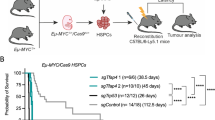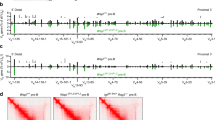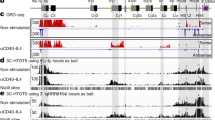Abstract
B-cell malignancies, such as human Burkitt’s lymphoma, often contain translocations that link c-myc or other proto-oncogenes to the immunoglobulin heavy chain locus (IgH, encoded by Igh)1. The nature of elements that activate oncogenes within such translocations has been a long-standing question. Translocations within Igh involve DNA double-strand breaks initiated either by the RAG1/2 endonuclease during variable, diversity and joining gene segment (V(D)J) recombination, or by activation-induced cytidine deaminase (AID, also known as AICDA) during class switch recombination (CSR)2,3,4. V(D)J recombination in progenitor B (pro-B) cells assembles Igh variable region exons upstream of μ constant region (Cμ) exons, which are the first of several sets of CH exons (‘CH genes’) within a CH locus that span several hundred kilobases (kb)5,6. In mature B cells, CSR deletes Cμ and replaces it with a downstream CH gene6. An intronic enhancer (iEμ) between the variable region exons and Cμ promotes V(D)J recombination in developing B cells7. Furthermore, the Igh 3′ regulatory region (Igh3′RR) lies downstream of the CH locus and modulates CSR by long-range transcriptional enhancement of CH genes8,9,10. Transgenic mice bearing iEμ or Igh3′RR sequences fused to c-myc are predisposed to B lymphomas, demonstrating that such elements can confer oncogenic c-myc expression11,12,13,14,15,16. However, in many B-cell lymphomas, Igh–c-myc translocations delete iEμ and place c-myc up to 200 kb upstream of the Igh3′RR1. Here we address the oncogenic role of the Igh3′RR by inactivating it in two distinct mouse models for B-cell lymphoma with Igh–c-myc translocations. We show that the Igh3′RR is dispensable for pro-B-cell lymphomas with V(D)J recombination-initiated translocations, but is required for peripheral B-cell lymphomas with CSR-associated translocations. As the Igh3′RR is not required for CSR-associated Igh breaks or Igh–c-myc translocations in peripheral B-cell lymphoma progenitors, we conclude that this regulatory region confers oncogenic activity by long-range and developmental stage-specific activation of translocated c-myc genes.
This is a preview of subscription content, access via your institution
Access options
Subscribe to this journal
Receive 51 print issues and online access
$199.00 per year
only $3.90 per issue
Buy this article
- Purchase on Springer Link
- Instant access to full article PDF
Prices may be subject to local taxes which are calculated during checkout




Similar content being viewed by others
References
Küppers, R. & Dalla-Favera, R. Mechanisms of chromosomal translocations in B cell lymphomas. Oncogene 20, 5580–5594 (2001)
Lieber, M. R., Yu, K. & Raghavan, S. C. Roles of nonhomologous DNA end joining, V(D)J recombination, and class switch recombination in chromosomal translocations. DNA Repair (Amst.) 5, 1234–1245 (2006)
Ramiro, A. et al. The role of activation-induced deaminase in antibody diversification and chromosome translocations. Adv. Immunol. 94, 75–107 (2007)
Robbiani, D. F. et al. AID is required for the chromosomal breaks in c-myc that lead to c-myc/IgH translocations. Cell 135, 1028–1038 (2008)
Bassing, C. H., Swat, W. & Alt, F. W. The mechanism and regulation of chromosomal V(D)J recombination. Cell 109 (suppl.). S45–S55 (2002)
Chaudhuri, J. et al. Evolution of the immunoglobulin heavy chain class switch recombination mechanism. Adv. Immunol. 94, 157–214 (2007)
Henderson, A. & Calame, K. Transcriptional regulation during B cell development. Annu. Rev. Immunol. 16, 163–200 (1998)
Cogné, M. et al. A class switch control region at the 3′ end of the immunoglobulin heavy chain locus. Cell 77, 737–747 (1994)
Khamlichi, A. A., Pinaud, E., Decourt, C., Chauveau, C. & Cogne, M. The 3′ IgH regulatory region: a complex structure in a search for a function. Adv. Immunol. 75, 317–345 (2000)
Pinaud, E. et al. Localization of the 3′ IgH locus elements that effect long-distance regulation of class switch recombination. Immunity 15, 187–199 (2001)
Adams, J. M. et al. The c-myc oncogene driven by immunoglobulin enhancers induces lymphoid malignancy in transgenic mice. Nature 318, 533–538 (1985)
Janz, S. Myc translocations in B cell and plasma cell neoplasms. DNA Repair (Amst.) 5, 1213–1224 (2006)
Schmidt, E. V., Pattengale, P. K., Weir, L. & Leder, P. Transgenic mice bearing the human c-myc gene activated by an immunoglobulin enhancer: a pre-B-cell lymphoma model. Proc. Natl Acad. Sci. USA 85, 6047–6051 (1988)
Truffinet, V. et al. The 3′ IgH locus control region is sufficient to deregulate a c-myc transgene and promote mature B cell malignancies with a predominant Burkitt-like phenotype. J. Immunol. 179, 6033–6042 (2007)
Wang, J. & Boxer, L. M. Regulatory elements in the immunoglobulin heavy chain gene 3′-enhancers induce c-myc deregulation and lymphomagenesis in murine B cells. J. Biol. Chem. 280, 12766–12773 (2005)
Yan, Y., Park, S. S., Janz, S. & Eckhardt, L. A. In a model of immunoglobulin heavy-chain (IGH)/MYC translocation, the Igh 3′ regulatory region induces MYC expression at the immature stage of B cell development. Genes Chromosom. Cancer 46, 950–959 (2007)
Manis, J. P., Tian, M. & Alt, F. W. Mechanism and control of class-switch recombination. Trends Immunol. 23, 31–39 (2002)
Madisen, L. & Groudine, M. Identification of a locus control region in the immunoglobulin heavy-chain locus that deregulates c-myc expression in plasmacytoma and Burkitt’s lymphoma cells. Genes Dev. 8, 2212–2226 (1994)
Dariavach, P., Williams, G. T., Campbell, K., Pettersson, S. & Neuberger, M. S. The mouse IgH 3′-enhancer. Eur. J. Immunol. 21, 1499–1504 (1991)
Lieberson, R., Giannini, S. L., Birshtein, B. K. & Eckhardt, L. A. An enhancer at the 3′ end of the mouse immunoglobulin heavy chain locus. Nucleic Acids Res. 19, 933–937 (1991)
Lieber, M. R. The mechanism of human nonhomologous DNA end joining. J. Biol. Chem. 283, 1–5 (2008)
Zhu, C. et al. Unrepaired DNA breaks in p53-deficient cells lead to oncogenic gene amplification subsequent to translocations. Cell 109, 811–821 (2002)
Difilippantonio, M. J. et al. Evidence for replicative repair of DNA double-strand breaks leading to oncogenic translocation and gene amplification. J. Exp. Med. 196, 469–480 (2002)
Yan, C. T. et al. IgH class switching and translocations use a robust non-classical end-joining pathway. Nature 449, 478–482 (2007)
Wang, J. H. et al. Oncogenic transformation in the absence of Xrcc4 targets peripheral B cells that have undergone editing and switching. J. Exp. Med. 205, 3079–3090 (2008)
Wang, J. H. et al. Mechanisms promoting translocations in editing and switching peripheral B cells. Nature 460, 231–236 (2009)
Franco, S. et al. H2AX prevents DNA breaks from progressing to chromosome breaks and translocations. Mol. Cell 21, 201–214 (2006)
Ramiro, A. R. et al. Role of genomic instability and p53 in AID-induced c-myc–Igh translocations. Nature 440, 105–109 (2006)
Neri, A., Barriga, F., Knowles, D. M., Magrath, I. T. & Dalla-Favera, R. Different regions of the immunoglobulin heavy-chain locus are involved in chromosomal translocations in distinct pathogenetic forms of Burkitt lymphoma. Proc. Natl Acad. Sci. USA 85, 2748–2752 (1988)
Frank, K. M. et al. DNA ligase IV deficiency in mice leads to defective neurogenesis and embryonic lethality via the p53 pathway. Mol. Cell 5, 993–1002 (2000)
Acknowledgements
We thank L. G. Jiang for help with cloning translocation breakpoints. This work was supported by National Institutes of Health (NIH) grant CA92625 and the Leukemia and Lymphoma Society of America (LLS) SCORE grant to F.W.A. M.G. was a Special Fellow of the LLS and C.T.Y. was supported by an NCI training grant. M.G. and C.T.Y. were also supported by the de Villiers International Achievement Award of the LLS to F.W.A. E.P. was a Fellow of the Fondation pour la Recherche Médicale. F.W.A. is an Investigator of the Howard Hughes Medical Institute.
Author Contributions F.W.A. and M.G. planned studies and interpreted data. M.G. performed experiments, with technical help from J.M.B. C.T.Y generated CXP mice. E.P. and M.C. generated Igh3′RR-deleted mice and helped interpret data. F.W.A. and M.G. wrote the paper.
Author information
Authors and Affiliations
Corresponding author
Supplementary information
Supplementary Information
This file contains Supplementary Figures 1-7 with Legends and Supplementary Tables 1-2. (PDF 4441 kb)
Rights and permissions
About this article
Cite this article
Gostissa, M., Yan, C., Bianco, J. et al. Long-range oncogenic activation of Igh–c-myc translocations by the Igh 3′ regulatory region. Nature 462, 803–807 (2009). https://doi.org/10.1038/nature08633
Received:
Accepted:
Issue Date:
DOI: https://doi.org/10.1038/nature08633
This article is cited by
-
Contribution of classical end-joining to PTEN inactivation in p53-mediated glioblastoma formation and drug-resistant survival
Nature Communications (2017)
-
Early B-cell-specific inactivation of ATM synergizes with ectopic CyclinD1 expression to promote pre-germinal center B-cell lymphomas in mice
Leukemia (2015)
-
ATM deficiency augments constitutively nuclear cyclin D1-driven genomic instability and lymphomagenesis
Oncogene (2014)
-
Inter- and intratumoral heterogeneity of BCL2 correlates with IgH expression and prognosis in follicular lymphoma
Blood Cancer Journal (2014)
-
Atypical rearrangement involving 3′-IGH@ and a breakpoint at least 400 Kb upstream of an intact MYC in a CLL patient with an apparently balanced t(8;14)(q24.1;q32) and negative MYC expression
Molecular Cytogenetics (2013)
Comments
By submitting a comment you agree to abide by our Terms and Community Guidelines. If you find something abusive or that does not comply with our terms or guidelines please flag it as inappropriate.



